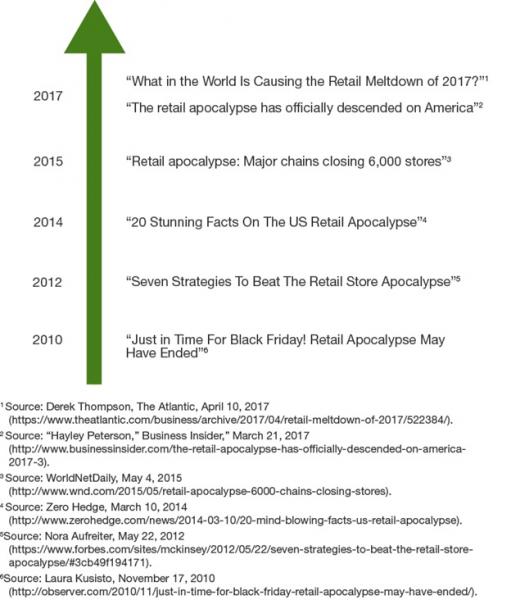Adaptable Teams Prevail Over Mythical Retail End Times
The press continues to highlight bankruptcies and store closings to support a theory that the entire retail market is in a death spiral. However, neither bankruptcies nor store closings accurately reflect the state of the retail market. In 2017 we see an actual Wikipedia page dedicated to the ‘retail apocalypse’. Headlines span the past seven years touting the doom of retail:

Retail bankruptcies numbered 20 in 2008, and this year they are tracking higher, but you can still count them on two hands.[1] The ten confirmed bankruptcies in 2017 included the well-known retailer Payless ShoeSource.[2] But these bankruptcies only show how specific companies have been challenged and are not indicative of the overall 3.3% growth in the retail market.[3] For starters, as of early May 2017, none of the top 100 retailers in the US went bankrupt.[4] Keep in mind, Chapter 11 is not liquidation, companies can recover, such as Ashley Stewart who recovered from a second bankruptcy in 2014.[5] Chapter 11 offers second (or third and fourth) chances to restructure, forgive debts and rebuild an organization.
…and Neither Are Store Closings
Retailers open and close stores all the time. They need to manage to changes in the market, geography, new store configurations, acquisition redundancies, lower leases, online buying trends and poor store performance. The US market is bursting with stores, for instance, in 2014, the top 100 US retailers alone accounted for 180,777 retail stores.[6] To date in 2017, 2,880 stores have closed through the end of March – or less than 1.6% of that total.[7] Even In 2008, at the depth of the recession, all of 6,163 retail stores shuttered their doors.[8] Keep in mind that retailers are opening stores as well.[9] For example, Target announced it is launching hundreds of small format stores beginning in 2017.[10] Dollar General is planning to open 1000 stores in 2017.[11]
Retailers Must Adapt to Manage Market Volatility
So, what are Target and Dollar General doing that provides impetus for growth? The best retailers will adapt their business teams to grow their business and cope with market changes. With an online market growing at 4x the offline rate, (but much smaller in absolute terms), new technologies such as AI capturing customer interest, and changes in customer habits, the need for retailers to adapt becomes apparent.[12]
So instead of worrying about the four horsemen of a retail apocalypse, smart digital retail leaders should focus on adapting to change through four facets of business: alignment, resource provisioning, operating speed, and customer experience. Together, these are the four facets of the digital retail adaptability flywheel. Proactively targeting and tackling these aspects of adaptability can help your digital teams evolve through a virtuous, continually improving path.
Learn more at the 2017 Forrester Digital Transformation Forum in Chicago, set up time to meet me at the event: 1:1 Analyst Meetings, read the Forrester report: The Four Facets of Adaptable Digital Commerce Teams when it publishes on May 10, or schedule a client inquiry with my fellow analysts and me on the Forrester Digital Commerce team.
[1] At the end of March 2017, there were nine recorded bankruptcies in the retail sector from notable retailers. Source: Krystina Gustafson, “Retail bankruptcies march toward post-recession high,” CNBC.com, March 31, 2017 (http://www.cnbc.com/2017/03/31/retail-bankruptcies-march-toward-post-recession-high.html).
[2]Source: “Payless Holdings,” Forbes (https://www.forbes.com/companies/payless-holdings/).
Source: “Top 100 Retailers 2016,” National Retail Federal (https://nrf.com/resources/annual-retailer-lists/top-100-retailers/stores-top-retailers-2016).
[3] Source: Forrester Data: Online Retail Forecast, 2016 To 2021 (US).
[4] Source: “Top 100 Retailers 2016,” National Retail Federation (https://nrf.com/resources/annual-retailer-lists/top-100-retailers/stores-top-retailers-2016).
[5] Source: Nicole Fallon, Business News Daily, July 31, 2015 (http://www.businessnewsdaily.com/8243-businesses-recovered-from-bankruptcy.html).
[6] Top 100 retailers, store count and details provided by Kantar Retail. Source: “Top 100 Retailers Chart 2015,” National Retail Federation (https://nrf.com/2015/top100-table).
[7] Source: “’The Retail Bubble Has Now Burst’: A Record 8,640 Stores Are Closing In 2017,” ZeroHedge, April 22, 2017 (http://www.zerohedge.com/news/2017-04-22/retail-bubble-has-now-burst-record-8640-stores-are-closing-2017).
[8] Source: “Store Closings Hit 8,300, Retail Vacancies Hit 17 Year High,” Retail Info Systems, October 20, 2009 (https://risnews.com/store-closings-hit-8300-retail-vacancies-hit-17-year-high).
[9] Source: Barbara Farfan, The Balance, April 7, 2017 (https://www.thebalance.com/us-retail-and-restaurant-chain-expansion-2892736).
[10] Source: Nathan Bomey, “Target planning 'hundreds' of small stores,” USA Today, November 16, 2016( https://www.usatoday.com/story/money/2016/11/16/target-small-format-stores/93952078/).
[11] Source: Krystina Gustafson, “These retailers are bucking the store closure trend—for better or worse,” March 20, 2017 (http://www.cnbc.com/2017/03/20/these-retailers-are-bucking-the-store-closure-trend.html).
[12] Source: Forrester Data Online Retail Forecast, 2016 To 2021 (US).
Learn more about retailers’ new technology initiatives for 2017 in the Forrester report “The State Of Retailing Online 2017: Key Metrics, Business Objectives, And Mobile.”